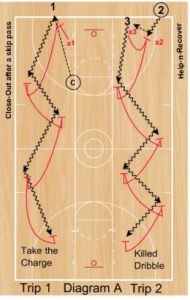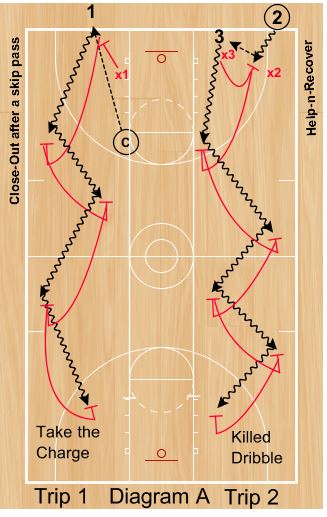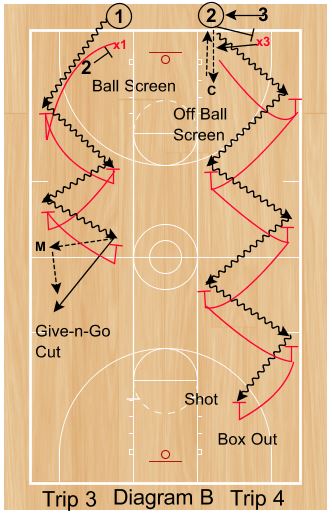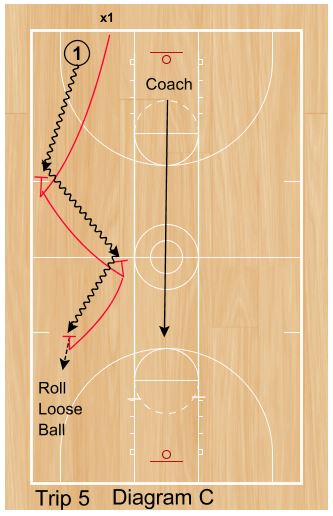
by Coach John Kimble
CoachJohnKimble.com
Retired high school and college coach
Published in Basketball Sense Magazine & in Winning Hoops
The “Pride Drill” can predominantly be an individual defensive drill that works on defensive techniques and skills. In addition to that, this drill is important in developing a tough hard-nosed attitude for every defensive player, as well as establishing a high intensity level for each player. With the physical and mental effort that this drill requires, the drill also becomes a great conditioning drill.
We also wish to incorporate offensive fundamental work into the drill (to add offensive work and additional intensity for both the offense and the defense). This drill, when properly performed by both the coaching staff and the players, will produce what the drill’s name is—that is pride in how well the players play defense.
Some of the offensive fundamentals and techniques that we can work on are the different kinds of screens, cuts, passes, and other offensive fundamentals that are used in every game. The various types of dribbling that we expect our players to be able to use in games are heavily worked on. The dribbles that we believe our players should use in games and should practice daily are: ‘behind-the-back’ dribbling, ‘between-the-leg’ dribbling, and ‘front-crossover’ dribbling. We constantly are emphasizing the proper techniques of all of these offensive fundamentals that are utilized in this drill. Each player is required to always go at “game speed”.
The Pride Drill can be expanded in different manners. One form of expansion is described below.
The drill is started with offensive restrictions for two important reasons. One reason is to allow the defense an opportunity to succeed before making the drill more difficult and more “game-realistic” as the defenders progress in developing skills and building confidence. The second reason for giving offensive restrictions is to force the offensive players into working on specific ball-handling techniques on which the coaching staff feels that either the team or individuals need to improve.
One way of making the drill more difficult (and therefore more “game-realistic”) is to lengthen and widen the dribbling area. At the beginning, it can be shortened and narrowed to promote success for the defenders. As the defenders master the defensive skills and techniques, the drill can be made more challenging and “game realistic” by expanding the offensive dribbling area.
We try to use the ‘overload theory’ in all of our drills to make the drills as tough as possible physically and mentally. The intensity level, the pressure, the competition, the demands, the ‘game-speed’ is to simulate game realism. If players can handle these demanding drills, they will be better prepared to handle the pressures and challenges that in an actual game. We want the games to be easier than the drills.
As the players develop their confidence, their ability level, and the proper techniques; we can expand the area used in The Pride Drill. When the drill area can be widened and lengthened to using the full length of the court, the drill can also then be expanded into improving on the many different defensive techniques being applied during the course of the Pride Drill.
Some of the defensive techniques that can be worked on and emphasized in the Pride Drill are: 1] taking the charge, 2] defending a “killed dribbler”, 3] defending a cutter [on a give-n-go situation], 4] boxing out a shooter [off of the dribble], 5] recover after the dribbler has actually beaten the defender, 6] diving for loose balls, 7] closing out on a potential driver/jump-shooter, 8] defending against an ‘on-the-ball’ screen, 9] defending against an ‘off-the-ball screen’, 10] helping out on a teammate’s man and then recovering onto his own man, 11] sprinting out of a ‘trap’ situation and picking up his own man, 12] “wolf” deflecting from behind and getting ahead of the dribbler, 13] jump-switching onto the new dribbler.
These and other defensive scenarios can be practiced at the very beginning and at the very end of the ‘dribbling area’. Different situations can be used every time at the beginning and at the end of each ‘offensive trip’ down the lane both offensively, as well as defensively. This keeps all players involved mentally alert and focused.
Some of the offensive scenarios that or offensive players can work on at the beginning of the ‘offensive trips’ are: a] simply receiving a normal pass, b] receiving ‘off the ball’ screens before catching the pass, c] shot-faking after receiving the pass, but before starting the dribble-drive, and d] after catching a pass and then receiving ball screens.
During the ‘offensive trip’, the dribbler may be asked to work on and/or use a specific type of dribble, or a to make a specific type of pass to a coach and the running a ‘give-n-go cut’.
At the end of the ‘offensive trip’, the dribbler may be required to shoot the ball, or charge into the defender, or kill the dribble, or roll the ball across the floor (to simulate a loose ball fumble).
It must be clearly stated that the defensive techniques that can be emphasized in the Pride Drill must be taught to the players first before they are stressed and emphasized in any drill. Once they are taught, they can be practiced and worked on, in this and other particular defensive drills.
Here is an example of the different ‘defensive trips’ that your team can work on. Different combinations should be changed daily. This will help all players learn how to listen and follow instructions, both offensively and defensively.
On the first trip down the court, the dribbler and the defender can create a situation where the defense must defend the new dribbler after he has received skip pass.
 The defender starts in a ‘pistol’ stance, as if he were playing help side defense and his man is more than two perimeter passes away from the ball. A coach could then skip-pass the ball to the defender’s man. This would then force the defender to start the first trip by ‘closing out’ on the new receiver-dribbler. The dribbler now zig-zags down the dribbling area (with the defender applying the proper ‘on-the-ball defensive techniques’. When the dribbler gets to the end of the lane, the defender then draws an offensive charge on the dribbler.
The defender starts in a ‘pistol’ stance, as if he were playing help side defense and his man is more than two perimeter passes away from the ball. A coach could then skip-pass the ball to the defender’s man. This would then force the defender to start the first trip by ‘closing out’ on the new receiver-dribbler. The dribbler now zig-zags down the dribbling area (with the defender applying the proper ‘on-the-ball defensive techniques’. When the dribbler gets to the end of the lane, the defender then draws an offensive charge on the dribbler.
The dribbler can simply put the ball into the chest of the defender to establish the physical contact required to initiate the offensive foul. There does not have to be any other physical contact between the two players, thus decreasing the risks of injuries to either participating player. When the ball has made the contact with the defender, the defender pushes off on his heels, falling to the floor. In drawing the charge, the following points of emphasis should be stressed to the players: 1] protect the groin and chest area by locking your arms in front of those two areas, 2] push off backward with the heels at the exact moment of contact, 3] tuck the chin, 4] try to slide on the tail on the floor, 5] raise the legs up into the chest area to protect from the offensive player landing on the defender, 6] grunt out an “ugh!” to help the official make the ‘charging’ call. The drill then continues with a new pair of players. We have the offensive player help the defender up after taking the charge.
The first pair of players go to the end of the line and switch defensive-offensive roles. SEE DIAGRAM A.
The second trip could begin with the main defender starting as a “one-pass-away” off-the-ball defender.
The ‘dummy dribbler’ should dribble into the gap of the two defenders. The main defender then “helps” (to stop penetration) and “recovers” to his original man as his offensive opponent receives the pass. From there, the defender uses the proper “push-push-push” and “drop step” techniques as he zig-zags down the dribbling alley. When the dribbler reaches the far baseline, he kills his dribble. This causes the defender to defend a “killed dribbler”. The major points that are highlighted in defending a “killed dribbler” are: 1] stepping up hard into the ‘killed’ dribbler and forcing the potential passer to put the ball over his head or to turn away from the hard defensive pressure that is being applied. This takes away the majority of the potential pass receivers that the passer has, [And remember that the passer has only 5 seconds to find that open receiver and make the pass to him] 2] cross face with the hands and prevent the passer from bringing the ball back down to waist or chest level, 3] we want the defender to yell “”work!, work!, work” and pressure the passer as much as possible. SEE DIAGRAM A.
The third trip can be initiated with one or two ‘dummy-screeners’ “ball-screening” the defender.
 On the third trip down the defensive lane, the defender is still working on the proper ball defender’s techniques with his feet and his hands. The proper stance is stressed with the proper “push” technique of the feet legs. The “dig hand” and the “extended hand and arm” techniques are constantly reinforced. The defender must feel for the screen and ‘go over the top (ball side of the screen) and hustle to stay or get ahead of the dribbler.
On the third trip down the defensive lane, the defender is still working on the proper ball defender’s techniques with his feet and his hands. The proper stance is stressed with the proper “push” technique of the feet legs. The “dig hand” and the “extended hand and arm” techniques are constantly reinforced. The defender must feel for the screen and ‘go over the top (ball side of the screen) and hustle to stay or get ahead of the dribbler.
After turning the dribbler several times down the dribbling alley, the dribbler passes the ball to a coach or manager who is standing near the mid court line. As soon as that pass is made, the dribbler-passer becomes a cutter-receiver. He makes a very hard “give-n-go” cut toward the end of the alley. The defender has to become a defender against a receiver (instead of a dribbler) and defend the ‘give-n-go’ cut. The defender should “jump to the ball” and “match hands and belly-buttons”. He should yell “Help!” and snap his head and look down his new ‘long-arm’, attempting to see the ball and his man. The dummy passer should force a pass to the give-n-go cutter, resulting in either a completion, a pass deflection, or an interception. SEE DIAGRAM B.
The fourth trip could start with an ‘off-the-ball’ screen on the original defender.
He should go ‘ball side’ of the screen, “skinny and slide through with a ‘long-arm’”. The defender should go full speed but allow the pass to be made. Once the pass is completed, the dribbling and the defensive zig-zagging starts again down the dribbling alley, with both players working on their respective techniques. At the end of the fourth trip, the dribbler jumps and shoots the ball at an imaginary basket several feet in front of him (to simulate a jump shot off of the dribble). At the end of this trip, the defender works on defending a shooter and also boxing out a shooter.
The defender defends against the shot by: 1] not leaving the ground until the shooter leaves the ground, 2] extending the hand [nearest the ball] and arm as high as possible, 3] front-pivots into the shooter and boxes out the shooter. The defender should maintain contact on the shooter for 3 seconds before quitting. Cardinal rules that we stress to our defenders on the shooter are: a] don’t foul a jump-shooter’, b] don’t leave the ground until the shooter leaves the ground, c] don’t give the shooter a second scoring opportunity. SEE DIAGRAM B.
On the fifth trip down the floor, the dribbler is allowed a two-step advantage on the defender.
 The ball defender works on the premise that the offensive dribbler has beaten him and he is to recover and continue guarding the offensive player. The defender must realize that he is beaten, pivot and open up, get the correct pursuit angle and sprint to a spot ahead of the advancing dribbler. He then must get in front of the dribbler and be “squared up” on him, knowing that the dribbler will then most likely try to change directions.
The ball defender works on the premise that the offensive dribbler has beaten him and he is to recover and continue guarding the offensive player. The defender must realize that he is beaten, pivot and open up, get the correct pursuit angle and sprint to a spot ahead of the advancing dribbler. He then must get in front of the dribbler and be “squared up” on him, knowing that the dribbler will then most likely try to change directions.
He should anticipate another defensive change of direction. The “point of emphasis” teaching phrase we use at this point is to tell the defense “they are there physically, but mentally they are already drop-stepping toward the new direction by the dribbler. The dribbler then continues “zig-zagging” down toward the far baseline. At the end of the trip, the dribbler simulates a fumbled loose ball. After the dribbler kills his dribble, he simply rolls out a ball for the defender to dive after—simulating a fumble. SEE DIAGRAM C.
Obviously, this is definitely a defensive-minded drill that requires effort from both all players as well as coaches. But the drill can be enhanced by having the dribbler working with both hands on the various types of dribbles the coaching staff allows. The head should stay up, with the body in a semi-crouch, dribbling quickly but not in a hurry. The various dribbles used could be any or all of the following: 1] the front crossover, 2] the between-the-legs dribble, 3] the behind-the-back dribble. The coaching staff could instruct the dribblers to use specific dribbles to improve upon, or a combination of them to work on offensive improvement.
Coaches should constantly be moving up and down the coaching alley, (SEE DIAGRAM C), as they constantly are teaching, correcting, cheering, motivating, and leading (by example). The more ‘points of emphasis’ and excitement the coach staff can generate and demonstrate (by example) the more motivated the players will be. Players will feed off of other players’ and coaches’ intensity level and desire. Enthusiasm, desire, and effort all are contagious and will spread throughout the team.
Coaches should be demanding, detailed, and offer constructive criticism whenever it is needed, but positive in their teaching the techniques. It is very important that coaches work hard at being a good example to the players in the proper levels of intensity, excitement, energy, and their own effort during the drill.
DEFENSIVE ‘PRIDE DRILL’ STATIONS
(STARTING SITUATIONS)
A. “Closeout” from a Skip-pass
B. Help-N-Recover
C. Ball Screen
D. Off-the-ball screen
E. From a Beaten Position
F. ’55 Soft’ Defensive Action
G. ‘Jump Switch’ Action
H. Sprint out of trap to the dribbler
I. ‘Wolf! Wolf! to become a ‘Container’
J. From a ‘Stalker’ to become a ‘Container’
(FINISHING SITUATIONS)
K. Draw the Charge
L. “Work! Work!” on a ‘killed dribbler’
M. ‘Give-n-Go Cutter’
N. Defend and box-out a ‘shooter’
O. Dive for a loose ball
P. Trap a new receiver
Q. Live “1 on 1′ Action
The dribbler must zig-zag and finally force the defense into the ‘paint’ and then shoot the ball. He must then get an offensive rebound for a ‘stickback’. When the defender gets the defensive rebound, he then must ‘dribble outlet’ the ball until the ‘new’ defender “turns” him at least one time.
R. Live “1 on 1” Action
The offensive dribbler must try and beat the defender, using both boundary lines, regardless of how wide or narrow they are. The dribbler should use both hands with his head constantly up looking at the rim. He should be using the various types of dribbles he can use.
There are countless combinations of ‘starting and ending’ situations that can be utilized. Mixing these combinations up helps eliminate boredom and complacency of the players. They are forced to listen and concentrate on remembering the many different defensive scenarios that the coaching staff lays out for them in this drill. This variety of scenarios will not only improve players’ concentration , but will also help defensive players improve on the many different defensive skills and techniques to be a better overall defender. Offensive players can also improve many different offensive ball-handling skills and techniques in this defensive-minded breakdown drill.
About the Author
Coach Kimble was the Head Basketball Coaching position at Deland-Weldon (IL) High School for five years (91-43) that included 2 Regional Championships, 2 Regional Runner-Ups and 1 Sectional Tournament Runner-up. He then moved to Dunlap (IL) High School (90-45) with 2 Regional Runners-up, 1 Regional, 1 Sectional and 1 Super-Sectional Championship and a final 2nd Place Finish in the Illinois Class A State Tournament. He was an Assistant Basketball Coach at Central Florida Community College in Ocala, FL for 4 years, followed with 10 years as the Head Basketball Coach at Crestview (FL) High School, averaging over 16 wins per season.
He also has had articles published in the following publications such as: The Basketball Bulletin of the National Association of Basketball Coaches, the Scholastic Coach and Athletic Journal, Winning Hoops, Basketball Sense, and Coaching Basketball. He has also written and has had five books published along with over 25 different DVDs by Coaches Choice and Fever River Sports Production.
See him on Twitter @CoachJohnKimble and his Web Page “www.CoachJohnKimble.com”







Those are the ones